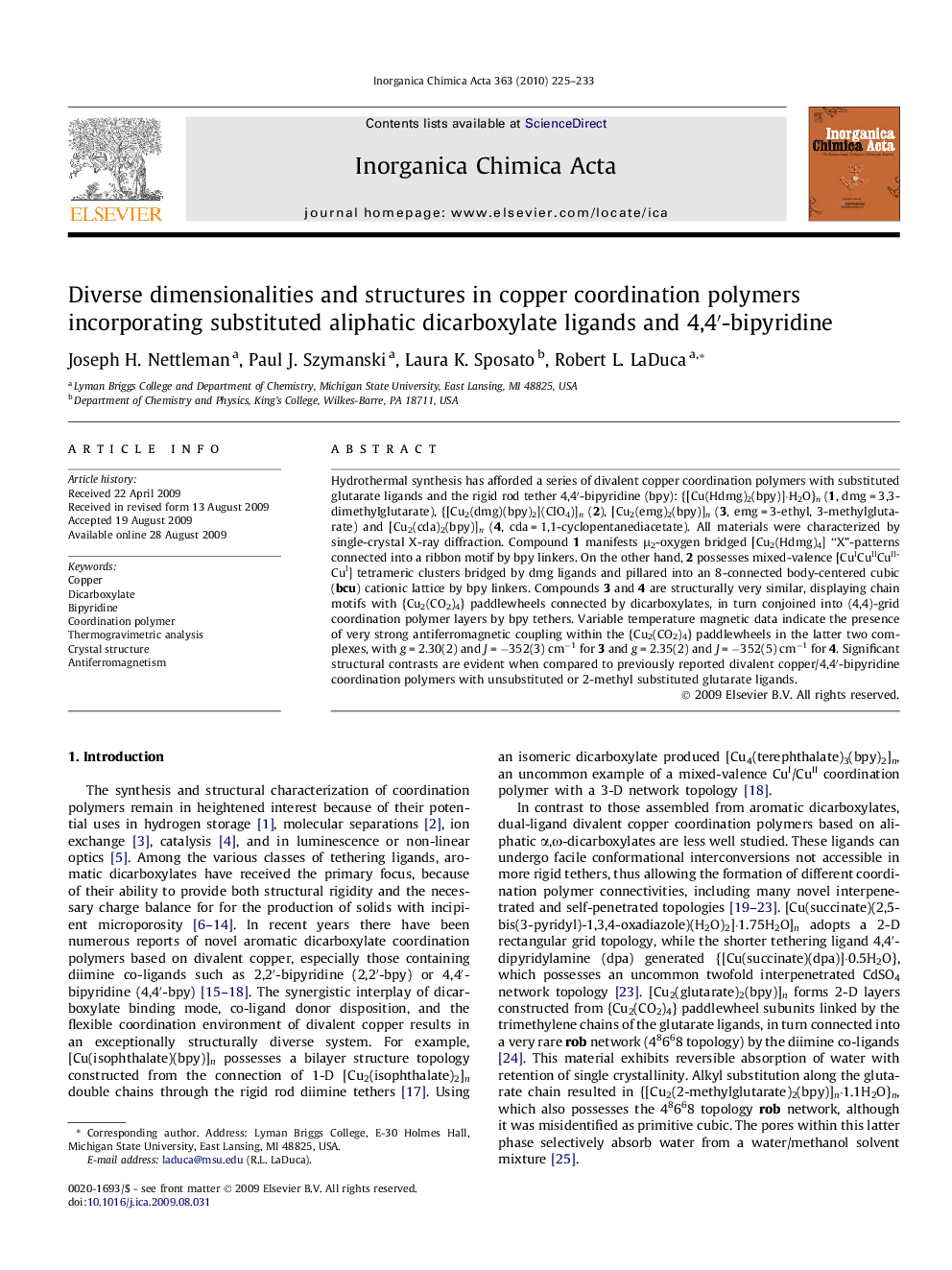| کد مقاله | کد نشریه | سال انتشار | مقاله انگلیسی | نسخه تمام متن |
|---|---|---|---|---|
| 1311319 | 975310 | 2010 | 9 صفحه PDF | دانلود رایگان |

Hydrothermal synthesis has afforded a series of divalent copper coordination polymers with substituted glutarate ligands and the rigid rod tether 4,4′-bipyridine (bpy): {[Cu(Hdmg)2(bpy)]·H2O}n (1, dmg = 3,3-dimethylglutarate), {[Cu2(dmg)(bpy)2](ClO4)]n (2), [Cu2(emg)2(bpy)]n (3, emg = 3-ethyl, 3-methylglutarate) and [Cu2(cda)2(bpy)]n (4, cda = 1,1-cyclopentanediacetate). All materials were characterized by single-crystal X-ray diffraction. Compound 1 manifests μ2-oxygen bridged [Cu2(Hdmg)4] “X”-patterns connected into a ribbon motif by bpy linkers. On the other hand, 2 possesses mixed-valence [CuICuIICuIICuI] tetrameric clusters bridged by dmg ligands and pillared into an 8-connected body-centered cubic (bcu) cationic lattice by bpy linkers. Compounds 3 and 4 are structurally very similar, displaying chain motifs with {Cu2(CO2)4} paddlewheels connected by dicarboxylates, in turn conjoined into (4,4)-grid coordination polymer layers by bpy tethers. Variable temperature magnetic data indicate the presence of very strong antiferromagnetic coupling within the {Cu2(CO2)4} paddlewheels in the latter two complexes, with g = 2.30(2) and J = −352(3) cm−1 for 3 and g = 2.35(2) and J = −352(5) cm−1 for 4. Significant structural contrasts are evident when compared to previously reported divalent copper/4,4′-bipyridine coordination polymers with unsubstituted or 2-methyl substituted glutarate ligands.
Hydrothermal synthesis has afforded a series of divalent copper coordination polymers with substituted glutarate ligands and the rigid rod tether 4,4′-bipyridine (bpy): {[Cu(Hdmg)2(bpy)]·H2O}n (1, dmg = 3,3-dimethylglutarate), {[Cu2(dmg)(bpy)2](ClO4)]n (2), [Cu2(emg)2(bpy)]n (3, emg = 3-ethyl, 3-methylglutarate) and [Cu2(cda)2(bpy)]n (4, cda = 1,1-cyclopentanediacetate). While 1 has a 1-D ribbon structure, 2 possesses mixed-valence tetrameric clusters linked into a 8-connected body-centered cubic lattice. Compounds 3 and 4 have strongly antiferromagnetically coupled {Cu2(CO2)4} paddlewheels connected into (4,4)-grid coordination polymer layers.Figure optionsDownload as PowerPoint slide
Journal: Inorganica Chimica Acta - Volume 363, Issue 1, 4 January 2010, Pages 225–233